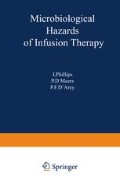Abstract
Intravenous infusion fluids have been in clinical use for nearly a century and a half. The first recorded intravenous infusion was given by Dr Thomas Latta of Edinburgh during the cholera epidemic of 1832. In an attempt to save the life of an old woman patient, he injected into a vein 6 pints of water containing sodium chloride and carbonate. This infusion was administered over a period of 30 minutes. The patient died, but with constant nursing attention and frequent saline infusions, Dr Latta managed to save the lives of five out of 15 cholera victims.
Access this chapter
Tax calculation will be finalised at checkout
Purchases are for personal use only
Preview
Unable to display preview. Download preview PDF.
References
Rosenheim, M. L. (Chairman) (1972). Interim report on heat sterilized fluids for parenteral administration. (London: HMSO)
Davis, N. and Turco, S. (1971). A study of paniculate matter in infusion fluids: Phase 2. Am. J. Hosp. Pharm. ,28, 620
Phillips, I. and Eykyn, S. (1972). Contaminated drip fluids. Br. Med. J., 1, 746
Phillips, I., Eykyn, S. and Laker, M. (1972). Outbreak of hospital infection caused by contaminated autoclaved fluids. Lancet ,i, 1258
Clothier, C. M. (Chairman) (1972). Report of the Committee appointed to enquire into the circumstances, including the production, which led to the contaminated infusion fluids in the Devonport Section of Plymouth General Hospital. (London: HMSO).
Meers, P. D., Calder, M. W., Mazhar, M. M. and Lawrie, G. M. (1973). Intravenous infusion of contaminated dextrose solution. The Devonport incident. Lancet, ii ,1189
Editorial (1972). Pharmacy practice. Pharm. J. ,208, 427
Rosenheim, M. L. (Chairman) (1973). Report on the prevention of microbial contamination of medicinal products. (London: HMSO)
D’Arcy, P. F. and Griffin, J. P. (1974). Drug Interactions: 2. By mixing drugs before administration. Preservers’ J. ,14, 38
D’Arcy, P. F. and Thompson, K. M. (1974). Drug additives to intravenous infusions: A survey of 10 hospitals in Ulster. Pharm. J. ,213, 172
Griffin, J. P. and D’Arcy, P. F. (1975). A Manual of Adverse Drug Inter actions. pp. 6–13 (Bristol: Wright)
Editorial. (1974). Microbiological hazards of intravenous infusions. Lancet ,i, 543
Hughes, G. (1973). 24-hour IV service. Pharm. J. ,211, 161
Brodlie, P., Henney, C. and Wood, A. J. J. (1974). Problems of administering drugs by continuous infusion. Br. Med. J. ,i, 383
Harrison, P. I. and Lowe, I. W. S. (1974). Practical ward study of intravenous additives. J. Hosp. Pharm. ,32, 31
Timoney, R. F. and Harte, V. (1974). Personal communication to the author
Woodside, W., Woodside, M. E., D’Arcy, P. F. and Patel, R. H. (1975). Intravenous fluids as vehicles of infection. Pharm. J. ,215, 606
Miller, W. A., Smith, G. L. and Latiolais, C. J. (1971). A comparative evaluation of compounding costs and contamination rates of intravenous admixture systems. Drug Intell. Clin. Pharm. ,5, 51
Myers, J. A. (1972). Millipore infusion filter unit: Interim report of clinical trial. Pharm. J. ,208, 547
Newman, M. S., Dempsey, G. and Walker, J. (1975). Microbial and particulate contamination during prolonged use of intravenous infusion sets. J. Hosp. Pharm. ,33, 95
Allwood, M. C. (1975). Microbial contamination of sterile fluids in glass containers. J. Hosp. Pharm. ,33, 119
Editor information
Editors and Affiliations
Rights and permissions
Copyright information
© 1976 MTP Press Ltd
About this chapter
Cite this chapter
D’Arcy, P.F. (1976). Additives—an additional hazard?. In: Phillips, I., Meers, P.D., D’Arcy, P.F. (eds) Microbiological Hazards of Infusion Therapy. Springer, Dordrecht. https://doi.org/10.1007/978-94-011-6179-4_3
Download citation
DOI: https://doi.org/10.1007/978-94-011-6179-4_3
Publisher Name: Springer, Dordrecht
Print ISBN: 978-94-011-6181-7
Online ISBN: 978-94-011-6179-4
eBook Packages: Springer Book Archive

